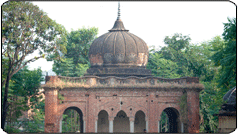Bagh Baba Hazara
With the oncoming Dussehra festival, the Sangat of Baba Hazara in the old city is all prepared to hold the ten day stage performances of Ram Leela at Bagh Baba Hazara [which is situated at a short distance from Imambara of Moghul Saheba]. On Vijaydashami, the tenth day, huge effigies of Ravana and Meghnad are set ablaze here at sunset. Three days later, on the occasion of Raj tilak abhishek of the victorious Lord Rama, Raas Leela is performed throughout the night by mandali from Mathura and Vrindavan, that provides a fanfare of folk music and dance.
Significantly, Baba Hazara's choice of^permanent abode at Lucknow is a concrete example of the secular credentials of Nawabs of Awadh.
Originally belonging to village Hazara in Jullunder district of Punjab, Baba Hazara, a Nanak-shahi saint is believed to have arrived at Lucknow in the reign of Nawab Shuja-ud-Daulah (1753-1775). The details of his life given here have been obtained from a booklet published by the Sangat in 1984 which are based on a lyrical narrative of Mata Prasad Naisha titled Baba Hazara ki Badshahi published in 1929. Born to a Brahmin couple, Baba Hazara left his home at the age of seven years. Roaming with a group of sadhus (ascetics), five years later he arrived at the ashram of Baba Dayal Shah and stayed with him and was earmarked as the chief chela (disciple). The samadhi of Baba Dayal Shah is at Fatuha in Bihar.
Touring on foot for pilgrimage of the holy places in the mountains, on way to Mount Kailash, Baba Hazara saw a dream where he had the darshan of Lord Shiva, and was told that he would find two tiger cubs responding to the names of Riddhi and Siddhi and that he should adopt them and keep them with himself.
After his visit to holy places like Ayodhya, Nimshranya and Bithoor, Baba Hazara halted at a place called Suraj Kund situated near Lucknow [on Mohaan road]. A wood-cutter happened to see him with the tiger cubs keeping company and playing with him. He narrated the encounter to the villagers who came flocking to make their obeisance to the holy man and seek his blessings. Soon the fame of Baba Hazara spread to Lucknow and devotees from the city including one Natha Mai Jat came to seek his blessings. They requested Baba Hazara to reside at Lucknow and the Jat offered his own garden in Ahata Surat Mai near Garhi Pir Khan for his abode. The large compound now belongs to the Sangat of Baba Hazara and is known as Bagh Baba Hazara.
All holy men are revered for their miracles and supernatural powers that are attributed to them. We find at least three miracles of Baba Hazara narrated alongwith the Nawabs of Awadh, mentioned in the booklet of the Sangat.
One miracle that is said to have happened in the presence of Nawab Shuja-ud-Daulah is the greening of a dead neem tree under which the Baba was meditating. The ruler himself visited the holy man at Lucknow since Baba Hazara had declined to go to Faizabad, to bless the Nawab at his residential palace. The Nawab finding the Baba sitting in the heat of sun without a shade remarked about it. Baba exclaimed that ascetics shun wordly comforts but may be the ruler needed to have a shade and with that the Nawab and his companions were astonished to find the dead neem tree turn green with leaves and branches providing the shade.
Baba Hazara is said to have breathed his last under this neem tree in 1799 and his samadhiIs erected at this site. Adjoining it is his successor's samadhi, that of Baba Amriti Das, who had built the samadhi of his guru.
Two other miracles of Baba Hazara are related with Nawab Asaf-ud-Daulah (1775-1797). The Nawab came to pay his respects to Baba Hazara and thank him for his relief work during the great famine. It was a chilly winter morning and while the Baba was in meditation, the Nawab covered him with his doshala (shawl) studded with precious jewels. Baba appreciated the considerate gesture of Asaf-ud-Daulah. However, Baba Hazara then put the shawl in the ceremonial fire lighted before him, emphasising that ascetics only needed ashes to cover their bodies. On his return to the palace, the Nawab was told by his Begum that he had left his shawl in the palace. The Nawab who had seen it turn to ashes was indeed surprised to find it intact at the palace. Rather, there was an addition of another similar shawl, which had not been there earlier.
A rare example of extreme religious tolerance and communal harmony is seen in the other miracle attributed to the Baba. A brahmin came to him seeking cure for his white patches caused by leprosy. Baba Hazara advised him to take the water already used by Nawab Asaf-ud-Daulah for his bath and pour it over his own body. The man, fearing his ouster from his caste and brotherhood of faith, appeared reluctant. Baba Hazara insisted and sent him to the Nawab with his letter. The leper is believed to have been miraculously cured and the white patches disappeared as soon as he poured the water used by Asaf-ud-Daulah on his body.
Bagh Baba Hazara has three Baradan and a large Kothi with a courtyard in the centre. The Kothi is adorned with a beautiful double storeyed entrance bearing the symbolic pair of fish motif of Awadh. The grand baradaris have beautiful stucco mouldings and stone brackets carved in the shape of elephant heads, fixed all around the exterior (to support the overhanging stones that are in use as sun shades). The Samadhi rooms are richly decorated with floral patterns and idols of gods and goddesses that are mounted overhead.
Interestingly, the kharbuza (melon) stripes design of radial ornamentation, seen within the domes and round ceilings of Nawabi buildings, is also visible in the inner sanctum of the closed baradari structures that contain the Samadhi of the mahants. signifying their close association with the Nawabs of Awadh.
Source:
Hindustan Times, City Scan, A Time in History
Wednesday 13.10.1999 — From land of five rivers to Gomti banks

